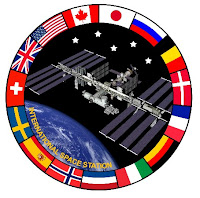
ESA - Space Robotics logo / ISS - International Space Station logo.
Dec. 2, 2015
Robonaut 2 in the Destiny laboratory. Image Credit: NASA
It seems that every science fiction story has a robot tightly woven into its narrative. Where there are space travelers, there are robotic sidekicks - often of the clunky metal figure variety - moving mechanically and speaking with a modified, monotone voice or series of beeps and bleeps. Robotics aboard the International Space Station (ISS), though, are helping us advance medical procedures on Earth and preparing us future deep space exploration.
Throughout December, the ISS Research and Technology team will focus on the wide range of robotic advancements in which the orbiting laboratory has played a crucial role. From work that has been in progress for years and has already yielded extraordinary results here on Earth, to new technology that is set to launch this week, robotics has been and continues to be a critical part of the science taking place aboard the space station.
A view of the Canadarm2 on orbit. Image Credit: NASA
Can you imagine orbiting the Earth at 17,500 miles per hour, and using a rover on Earth to pick up a phone charger and plug it in to an outlet? Imagine being able to even feel when the plug has been inserted, all while you are hundreds of miles above the planet. Astronauts on the ISS are participating in European Space Agency (ESA) investigations where they are driving rovers here on Earth, and are performing tasks with sub-millimeter precision. Being able to send robots to the surface of a planet, operate them with extreme precision and receive tactile feedback from orbit will save money and lower risks for future exploration.
While distant exploration is benefiting from robotics aboard the space station, so are people back on Earth. The Image-Guided Autonomous Robot (IGAR) was created using technologies from both the space shuttle and space station, including the Canadian Space Agency (CSA) Canadarm, Canadarm2 and Dextre. IGAR works in tandem with an MRI scanner to aid in more precise targeting of tumors, and in needle-based biopsies or lesion removal.
Image above: Japan Aerospace Exploration Agency (JAXA) astronaut Kimiya Yui performs experiment protocols for the rack-mounted configuration of the European Space Agenecy’s (ESA’s) Haptics-1 investigation. Image Credit: NASA.
CSA’s Canadarm and Candarm2 also lead to the development of neuroArm, a surgical robot that can improve precision and accuracy during brain surgery. Watch this touching video that shows how neuroArm helped a young mother get a new lease on life after being diagnosed with multiple brain tumors.
Of course, no discussion of robotics on the space station would be complete without a mention of Robonaut2. The dexterous humanoid robot has called the space station home since 2011, and is designed to be able to complete simple, repetitive or even dangerous tasks.
Animation above: European Space Agency’s (ESA) Eurobot rover under live control by astronaut Alexander Gerst aboard the space station. Animation Credit: ESA.
New robotic technologies are continuously developed for the orbiting laboratory. The ISS Robotic External Ammonia Leak Locator (ISS External Leak Locator) is set to launch Dec. 3 aboard the Cygnus spacecraft. The tool will be tested on its ability to detect ammonia leaks on the space station’s exterior, a task that usually requires a risky spacewalk by astronauts.
Humans can do great things while in space, but having the assistance of a robot can not only advance future exploration, it can also lead to great things back on Earth. The robotic sidekicks may not look like the science fiction droids of fiction, but it’s clear their role is important. Join us as we explore these robotic stories this month.
Related links:
International Space Station (ISS): http://www.nasa.gov/mission_pages/station/main/index.html
ISS Research and Technology: http://www.nasa.gov/mission_pages/station/research/index.html
Image-Guided Autonomous Robot (IGAR): http://www.nasa.gov/station/research/news/igar/
neuroArm: http://www.nasa.gov/mission_pages/station/research/news/neuro_canadarm/
Robonaut2: http://robonaut.jsc.nasa.gov/default.asp
ISS External Leak Locator: http://www.nasa.gov/mission_pages/station/research/experiments/1817.html
Canadian Space Agency (CSA): http://www.asc-csa.gc.ca/eng/iss/default.asp
Images (mentioned), Animation (mentioned), Text, Credits: NASA’s Johnson Space Center/ Kristine Rainey/International Space Station Program Science Office/Rachel Hobson.
Greetings, Orbiter.ch





